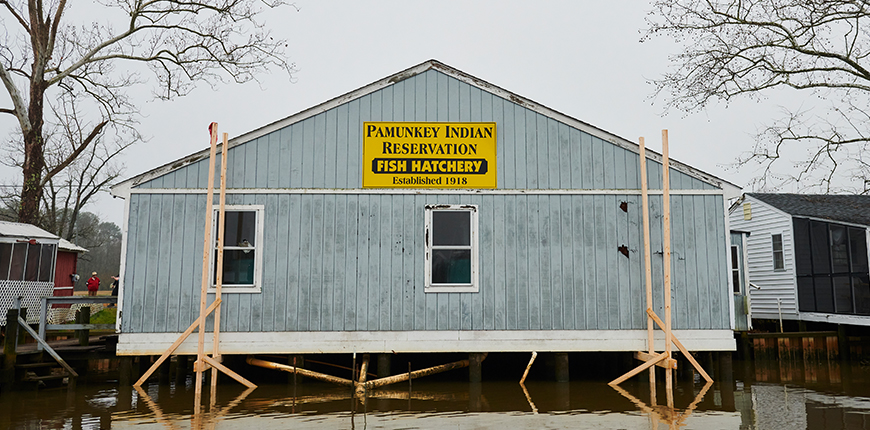
Fish Hatchery
The Pamunkey Indians have depended on fishing, hunting, trapping and gardening for hundreds of years for our subsistence. One of the main staples of our diet for the past one hundred and fifty years has been fish, specifically shad and herring. Members of the Pamunkey Indian Tribe also bartered these fish, making them an integral part of our economy.
The Pamunkey have maintained a philosophy that if you took fish from the water, you should put some back. We started an indoor fish hatchery in 1918, with an 800 gallon holding tank, gas-powered motor, hatching jars and holding tanks. As soon as the eggs hatched, they were gravity-fed back into the Pamunkey River. The Commission on Fishing helped with this design and other technical information.
As time passed, we received little support from the Commonwealth of Virginia, and during the 1940s, we had to shut down our operation. During the 1950s, we started another approach of hatching shad by using tidal boxes. The Virginia Marine Resource Commission (VMRC) approved this approach, and the Tribe received financial assistance to maintain this hatchery. In 1989, we decided that we needed an improved method of hatching. With the federal government's help, we constructed a new indoor fish hatchery with 12 hatching jars, a 500-gallon holding tank, 2 indoor tanks with incoming water from the river and an exit for the fry to go back into the river.
VMRC provided additional monetary support to run the hatchery purchase of shad spawn/sperm for the Pamunkey Fisherman. In addition, operators of the hatchery donated some of their time to make this operation viable.
In 1992, the Pamunkey Tribal Government (PTG) with the help of the VMRC, expanded the hatchery from 12 hatching jars to 24 and upgraded the facilities. In 1994, we increased the size of the fish hatchery to three holding tanks and held the fry for seven days, feeding them shrimp. We also upgraded our filtration system.
In 1998, The PTG moved to the next phase in developing the fish hatchery: tagging shad to help document life history characteristics. Spawning shad (broad stock) were manually spawned, and fertilized eggs were incubated in the hatchery. Upon hatching, the young shad fry was intensively cultured for about 16 days. During their stay at the hatchery, the fry was marked with Oxytetracyclin (OTC) on a set sequence of days that gave the shad produced from the hatchery a unique tag. All shad produced from this facility were released back into the Pamunkey River.
We added 12 holding tanks, a new plumbing system with oxygen and water going to all tanks, new brine shrimp hatching tanks and a new filtration system.
The Chesapeake Bay Program Grant and support from the Virginia Department of Game and Inland Fisheries made this possible.
Pamunkey Tribal Soil Climate Assessment Network
In September 2018, the United States Department of Agriculture Natural Resources Conservation Service (NRCS) installed a Tribal Soil Climate Assessment Network (TSCAN) to support natural resource assessments and conservation activities by collecting and reporting atmospheric and soil climate data. These data can be used to assess climate trends over time and inform critical Pamunkey natural resource concerns such as:
How are shifting climate patterns and extreme weather events, such as prolonged heat and drought, affecting river health and, thus, life cycles and habitat of culturally important species such as shad, sturgeon, and mussels?
How are our native plant communities responding to shifts in seasonal climate? How might this affect traditional Pamunkey foodways such as hunting and foraging?
In April 2024, NRCS dispatched their TSCAN team from Salt Lake City to the Pamunkey Indian Reservation to retrofit the instrument with a new solar panel, modem, and data logger, improving reporting reliability. These data can be viewed on NRCS’s Decision Tools Website by selecting “Pamunkey, VA” from the dropdown menu on the right side of the page.
Understanding the Pamunkey River
A Review of Water Science, Management, and Traditional Ecological Knowledge
The Pamunkey Indian Tribe, in collaboration with United States Geological Survey (USGS) and Virginia Commonwealth University's Rice Rivers Center, have developed a StoryMap to document the current state of water resources in the Pamunkey River. This report includes a review of relevant scientific studies combined with documentation of the Traditional Ecological Knowledge possessed by elders of the Pamunkey Indian Tribe through recorded interviews. The riparian habitats, woods, waters, wetlands a biota of the Pamunkey riverscape are critical to tribal health, economics, culture , and identity. The fate of the river and the tribe are inextricably linked, which is why stewardship of the Pamunkey River is crucial. This report identifies gaps in scientific and traditional understanding, and the ongoing and emerging threats to the Pamunkey River, its resources, and the people that live and depend on it.

